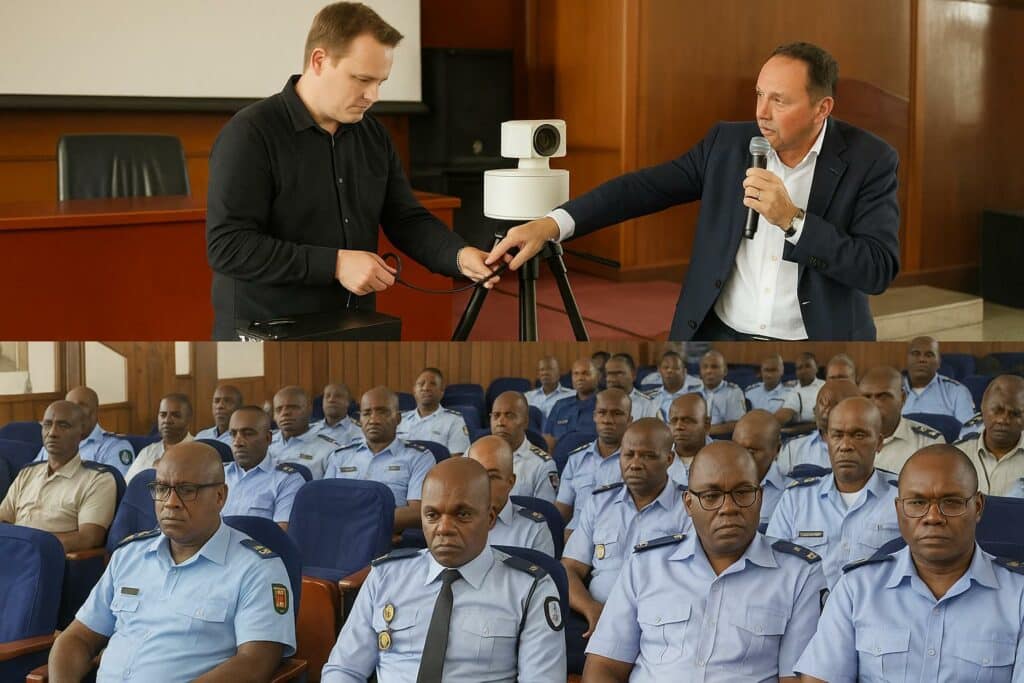Strategic Partnership for Safer Highways
The marble hall of the Brazzaville Prefecture was unusually animated on 24 September 2025. Beneath portraits of national leaders, the Directorate-General of Land Transport (DGTT) and the private operator La Congolaise des Frets (LCF) gathered some thirty officers from the police and the gendarmerie for an intensive seminar on mobile speed-control radars. The session was ceremonially opened by DGTT Director-General Atali Mopaya, whose address framed the project as an emblem of the state’s resolve to modernise public services and protect citizens. “Road safety is a public good; equipping our frontline forces with cutting-edge tools is an act of sovereignty,” he argued, drawing applause from the uniformed audience.
The event capped months of negotiations with Jenoptik, a German firm renowned for intelligent mobility solutions. Its commercial director, Cédric Mazet, travelled to Brazzaville to supervise both theory and hands-on modules. According to Mazet, the two tri-band radars acquired by Congo are “capable of detecting speeding vehicles over four lanes simultaneously and transmitting encrypted data in real time”—a quantum leap from handheld laser guns still common across Central Africa.
Inside the Radar Technology
During the practical simulation held on the Alfred Raoul Boulevard, trainees experienced the device’s automatic number-plate recognition and instant infraction logging. The equipment, mounted on discreet tripods, can be redeployed in under five minutes, a feature that, Mazet notes, “discourages habitual offenders who rely on word-of-mouth to evade fixed checkpoints.”
Captain Jean-Bruno Sandé, commander of the Brazzaville Traffic Unit, remarked that excessive speed on the boulevard and the Talangaï and Kintélé viaducts now constitutes the principal vector of crashes. “The radar’s evidentiary reliability will help us shift from persuasion to enforcement,” he stated. Preliminary data from the Ministry of Interior indicate that velocity is implicated in forty per cent of fatal accidents nationally (Ministry of Interior, 2024).
Training as a Pillar of Reform
Beyond familiarising officers with hardware, the seminar devoted several hours to accident-scene management, victims’ rights and de-escalation techniques. A legal module revisited the 2023 Road Code, particularly the graduated penalty system that aligns domestic practice with the African Road Safety Charter. Mopaya took the opportunity to announce the forthcoming integration of radar evidence into an electronic fine-collection platform, reducing cash handling and potential disputes.
À retenir : the training inaugurates a cascade strategy in which the thirty pioneer officers will become certified instructors for their respective units, thereby multiplying competence without spiralling costs. In Mopaya’s formulation, “Investing in people is the most sustainable form of capital expenditure.”
Legal and Economic Implications
Le point juridique/éco : the admissibility of digitally captured infractions was clarified by the High Court in its March 2025 Lafouéré ruling, which endorsed automated evidence, provided the calibration log is available to defence counsel. By meeting that jurisprudential threshold, Jenoptik’s devices should withstand courtroom scrutiny, reinforcing legal certainty for motorists and law-enforcement alike.
Economically, the radar system is financed through a mixed model: an initial state outlay of 400 million CFA francs, complemented by a performance-based maintenance contract with LCF. The Ministry of Finance projects that sanctioned infractions will generate enough revenue to amortise equipment costs within two years, freeing budgetary space for additional units along the Pointe-Noire corridor.
A National Commitment to Vision 2030
Congo-Brazzaville’s endorsement of the United Nations’ Decade of Action for Road Safety commits the country to halving traffic deaths by 2030 (UN General Assembly, 2020). The Marrakech World Road Safety Assembly in September 2025 reinforced that pledge, and Brazzaville’s radar pilot is its first tangible outcome. International observers, including the World Health Organization, commend the approach that couples enforcement with public outreach.
In the coming months, the DGTT plans televised campaigns and school outreach to embed a culture of compliance. “Technology, legislation and pedagogy must converge,” Mopaya insisted. As dusk settled over the capital, officers folded the tripods and stored the radars—symbols of a state quietly upgrading its governance toolkit. If the pilot succeeds, Congo-Brazzaville could well position itself as a sub-regional exemplar of data-driven traffic management, advancing both public safety and administrative modernity.

